Timeline of transportation technology
This is a timeline of transportation technology and technological developments in the culture of transportation.
| Part of a series on |
| Transport |
|---|
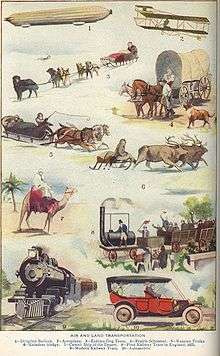 |
| Modes |
| Topics |
|
|
Antiquity

A traditional Polynesian catamaran
- 20th millennium BCE – rafts used on rivers.
- 7th millennium BCE – Earliest known shoes.
- 6th millennium BCE – Dugout canoes constructed.
- 4th millennium BCE – The earliest vehicles may have been ox carts.[2]
- 3500 BCE – Domestication of the horse and invention of the wheel in Ancient Near East
- Toys excavated from the Indus valley civilization (3010–1500 BCE) include small carts.
- 3000 BCE – Austronesians construct catamarans and outriggers.
- In the Mediterranean, galleys were developed about 3000 BC.
- 2nd millennium BCE – Cart mentioned in literature, chariot and spoked wheel invented.
- 800 BCE – Canal for transport constructed in Ancient China.
- 408 BCE – Wheelbarrow referenced in Ancient Greece.
Middle Ages

Horse collars and cart between 1350 and 1375
- 5th Century – Horse collar invented in China.
- 6th Century - Evidence of a horseshoe in the tomb of the Frankish King Childeric I, Tournai, Belgium.
- 800 – The streets of Baghdad are paved with tar.
- 9th century - The sine quadrant, was invented by Muhammad ibn Musa al-Khwarizmi in the 9th century at the House of Wisdom in Baghdad.[3]:128 The other types were the universal quadrant, the horary quadrant and the astrolabe quadrant.
- 10th Century – sea-going Junk (ship) ships built in China.
- Late 10th century – Kamal invented in Arab world.
- 1044 – Compass invented in China.
- 13th century (or before) – Rocket invented in China.
- 1350 – Compass dial invented by Ibn al-Shatir.
- 1479-1519 - Da Vinci sketches pedalo.
- 1495-1504 - The oldest extant cable railway is probably the Reisszug, a private line providing goods access to Hohensalzburg Fortress at Salzburg in Austria. This line is generally described as the oldest funicular.[4][5]
 Reisszug, as it appeared in 2011
Reisszug, as it appeared in 2011
- 15th century – Jan Žižka built the precursor to the motorised tank, armoured wagons equipped with cannons.
- 1569 - Mercator 1569 world map published.
- Late 16th century – European sailing ships become advanced enough to reliably cross oceans.
17th century
- 1620 – Cornelius Drebbel builds the world's first known submarine, which is propelled by oars (although there are earlier ideas for and depictions of submarines).
- 1655 - Stephan Farffler was a Nuremberg watchmaker of the seventeenth century whose invention of a manumotive carriage in 1655 is widely considered to have been the first self-propelled wheelchair.
- 1662 – Blaise Pascal invents a horse-drawn public bus which has a regular route, schedule, and fare system.
- 1672 – Ferdinand Verbiest built what may have been the first steam-powered scale model car.[6][7]
18th century
- 1716 – Swedish scientist, Emanuel Swedenborg, creates the first concept of a hovering vehicle.[8]
- 1731 - Sextant first implemented to accurately determine latitude.
- 1733 - William Kent developed an early stroller.[9]
- 1740 – Jacques de Vaucanson debuted his clockwork powered carriage.
- 1761 - Marine chronometer invented as a means to accurately determine longitude.
- 1769 – Nicolas-Joseph Cugnot demonstrates his fardier à vapeur, an experimental steam-driven artillery tractor
- 1776 – First submarine to be propelled by screws, and the first military submarine to attempt an attack on a ship, Turtle, is built by David Bushnell. The attack fails to sink HMS Eagle.
- 1779 - The Iron Bridge built in Shropshire.
- 1783 - First parachute.
- 1783 – Joseph Montgolfier and Étienne Montgolfier launch the first hot air balloons triggering Balloonomania.
- 1783 – Jacques Charles and Les Frères Robert (Anne-Jean Robert and Nicolas-Louis Robert) launch the first Hydrogen balloon.
- 1784 – William Murdoch built a working model of a steam locomotive carriage in Redruth, England.[10]
- 1789 - The pedal powered tricycle was invented by two Frenchmen, named Blanchard and Maguier.
- 1790s – Canal Mania, an intense period of canal building in England and Wales.
19th century
Early 19th century
- 1801 – Richard Trevithick ran a full-sized steam 'road locomotive' on the road in Camborne, England.[10]
- 1803 – Richard Trevithick built his 10-seater London Steam Carriage.[10]
- 1803 – William Symington's Charlotte Dundas, generally considered to be the world's first practical steamboat, makes her first voyage.
- 1804 – Richard Trevithick built a prototype steam-powered railway locomotive and it ran on the Pen-y-Darren Line near Merthyr Tydfil Wales.
- 1804 – Oliver Evans (claimed to have) demonstrated a steam-powered amphibious vehicle.
- 1807 - The Swansea and Mumbles Railway ran the world's first passenger horsecar tram service.
- 1807 – Robert Fulton's North River Steamboat, the world's first commercially successful steamboat, makes her maiden voyage.
- 1807 – Nicéphore Niépce installed his Pyréolophore internal combustion engine in a boat and powered up the river Saone in France.
- 1807 – Isaac de Rivas made a hydrogen gas powered internal combustion engine and mounted it on a vehicle.
- 1812 – First commercially successful self-propelled engine on land was Mathew Murray's Salamanca on Middleton Railway using toothed wheels and rail.
- 1812 – Timothy Hackworth's "Puffing Billy" ran on smooth Cast Iron Rails at Wylam Colliery near Newcastle
- 1814 – George Stephenson built the first practical steam-powered railway locomotive "Blutcher" at Killingworth Colliery.[11]
- 1816 – The most likely originator of the Bicycle is the German, Baron Karl von Drais, who rode his 1816 machine while collecting taxes from his tenants.
- 1819 – SS Savannah, the first vessel to cross the Atlantic Ocean partly under steam power, arrives at Liverpool, England from Savannah, Georgia.
- 1819 - Denis Johnson invents kick scooter.
- 1822 – Stevenson built a locomotive and designed the railway for Hetton Colliery which is first railway not to use any horse-traction but it did have several rope hauled sections.
- 1822 – First Meeting of Liverpool Manchester Railway Company Permanent Committee.[12]
- 1825 - Stevenson's Locomotion No. 1 runs on Stockton & Darlington Railway which opens as first public railway and uses horses and self-propelled steam engines and stationary engines with ropes along a single track. No stations and no timetables as anyone could hire the track to use their own vehicle on it.[13]
- 1825 – Sir Goldsworthy Gurney invented a series of steam-powered passenger carriages and by 1829 completed the 120-mile journey from London to Bath, Somerset and back.
- 1826 – Bill passed for Liverpool and Manchester Railway at second attempt and George Stevenson commences work on 35-mile twin track line permitting simultaneous travel in both directions between the 2 towns. Means of traction not specified to reduce opposition.[14]
- 1828 – Stevenson's "Lancashire Witch" runs on Bolton and Leigh Railway line - a public goods line to connect Leeds and Liverpool Canal and Manchester Bolton & Bury Canal. Railway has rope hauled and self-propelled steam engines and single track.[15]
- 1829 – Rainhill Trials to find best self-propelled engine for Liverpool Manchester line are won by Robert Stephenson's Rocket proving there is no need for horse traction or static engines on the main line.[16] Rocket becomes basic formula for all future steam engines with boiler tubes, blast pipe, and the use of coal rather than coke.
- 1830 – Liverpool and Manchester Railway opens. First public transport system without animal traction, first public line with no rope hauled sections for main journey, first twin track, first railway between 2 large towns, first timetabled trains, first railway stations, first train faster than a mail coach, first tunnels under streets, first proper modern railway which formed the template for all subsequent railways.[17]
- 1838 – Isambard Kingdom Brunel's SS Great Western, the first purpose-built transatlantic steamship, inaugurates the first regular transatlantic steamship service.
- 1839 - An early electric boat was developed by the German inventor Moritz von Jacobi in 1839 in St Petersburg, Russia. It was a 24-foot (7.3 m) boat which carried 14 passengers at 3 miles per hour (4.8 km/h). It was successfully demonstrated to Emperor Nicholas I of Russia on the Neva River.
- 1840s – Railway Mania sweeps UK and Ireland. 6,220 miles (10,010 km) of railway line were built
- 1843 - Dalkey Atmospheric railway opens.
- 1847 - The first steam railcar was designed by James Samuel, the Eastern Counties Railway Locomotive Engineer, built by William Bridges Adams in 1847, and trialled between Shoreditch and Cambridge on 23 October 1847.
Late 19th century
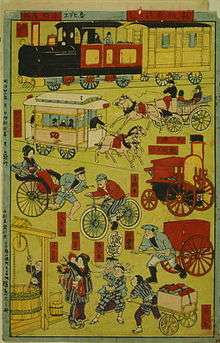
Late 19th century modes of transport, Japan, horsecar, bicycle etc.
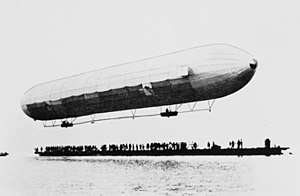
First Zeppelin ascent, 1900
- 1852 – Elisha Otis invents the safety elevator.
- 1853 – Sir George Cayley built and demonstrated the first heavier-than-air aircraft (a glider).
- - Quadracycle invented.
- 1859 - First model railway for Napoléon, Prince Imperial.
- 1862 – Étienne Lenoir made a gasoline engine automobile.
- 1863 – London's Metropolitan Railway opened to the public as the world's first underground railway.
- 1867 – First modern motorcycle was invented.
- 1868 – Safety bicycle invented.
- 1868 – George Westinghouse invented the compressed-air brake for railway trains.
- 1868 – Louis-Guillaume Perreaux's steam velocipede, a steam engine attached to a Michaux velocipede.[18]
- 1870 - First definite record of a kicksled.
- 1874 - Midland railway introduces the first bogie.
- 1875 - World's first electric tram line operated in Sestroretsk near Saint Petersburg, Russia, invented and tested by Fyodor Pirotsky.[19][20]
- 1880 – Werner von Siemens builds first electric elevator.
- 1881 - World's first commercially successful electric tram, the Gross-Lichterfelde tramway in Lichterfelde near Berlin in Germany built by Werner von Siemens who contacted Pirotsky. It initially drew current from the rails, with overhead wire being installed in 1883.
- 1882 - The trolleybus dates back to 29 April 1882, when Dr. Ernst Werner Siemens demonstrated his "Elektromote" in a Berlin suburb. This experiment continued until 13 June 1882
- 1883 - Mödling and Hinterbrühl Tram, Vienna, Austria, first electric tram powered by overhead wire.
- 1884 - Thomas Parker built a practical production electric car in Wolverhampton using his own specially designed high-capacity rechargeable batteries.
- 1885 – Karl Benz invents the first car powered by an internal combustion engine, he called it the Benz Patent Motorwagen.[21]
- 1889 - The first interurban tram-train to emerge in the United States was the Newark and Granville Street Railway in Ohio, which opened in 1889.
- 1889 - First introduced in 1889, battery vehicles milk floats expanded use in 1931 and by 1967 gave Britain the largest electric vehicle fleet in the world.
- 1890s – Bike boom sweeps Europe and America with hundreds of bicycle manufacturers in the biggest bicycle craze to date
- 1890 - The City and South London Railway (C&SLR) was the first deep-level underground "tube" railway in the world,[22][note 1] and the first major railway to use electric traction
- 1893 - Recumbent bicycles invented.
- 1893 - first moving walkway debuted at the World's Columbian Exposition.
- 1893 - The Liverpool Overhead Railway opened on 6 March 1893 with 2-car electric multiple units, the first to operate in the world.
- 1894 – Hildebrand & Wolfmüller became the first motorcycle available to the public for purchase.
- 1895 - First motorbus. In Siegerland, Germany, two passenger bus lines ran briefly, but unprofitably, in 1895 using a six-passenger motor carriage developed from the 1893 Benz Viktoria.[23]
- 1896 – Jesse W. Reno builds first escalator at Coney Island, and then reinstalls it on the Manhattan side of the Brooklyn Bridge.
- 1897 – Charles Parsons' Turbinia, the first vessel to be powered by a steam turbine, makes her debut.
- 1897 – Most likely the first electric bicycle was built in 1897 by Hosea W. Libbey.[24]
- 1899 - The Lohner-Porsche Mixte Hybrid was both the world's first hybrid vehicle, and the first four-wheel drive without a steam engine.
- 1899 – Ferdinand von Zeppelin builds the first successful airship.[25]
- 1900 – Ferdinand von Zeppelin launches the first successful airship.[25]
20th century
Early 20th century
.jpg)
Early 20th Century modes of road transport in Dublin, 1929
- 1903
- Orville Wright and Wilbur Wright – Fly the first motor-driven airplane.
- Diesel engine – Tested in a canal boat by Rudolph Diesel, Adrian Bochet and Frederic Dyckhoff.
- first diesel motorship was also the first diesel–electric ship, the Russian tanker Vandal from Branobel, which was launched in 1903
- 1904 - The first non-experimental trolleybus system was a seasonal municipal line installed near Nantasket Beach in 1904; the first year-round commercial line was built to open a hilly property to development just outside Los Angeles in 1910.
- 1907 - The London Electrobus Company started running a service of battery-electric buses between London's Victoria Station and Liverpool Street on 15 July 1907.
- 1908 – First mass produced automobile- Henry Ford develops the assembly line method of automobile manufacturing with the introduction of the Ford Model T.
- 1910 - Fabre Hydravion first seaplane.
- 1911 – Selandia launched – First ocean-going, diesel engine-driven ship.
- 1912 - The world's first diesel locomotive (a diesel-mechanical locomotive) was operated in the summer of 1912 on the Winterthur–Romanshorn railway in Switzerland.
- 1912 - Articulated trams, invented and first used by the Boston Elevated Railway.[26]
- 1914 - The first application of railway electric traffic light signals was by the Chicago, Milwaukee, St. Paul and Pacific Railroad's use of the US&S "Style L" colour light signal on their line through the Pacific Northwest.
- 1915
- The Luftkissengleitboot Hovercraft – First hovering vehicle was created by Dagobert Müller. It could only travel on water.
- Motorized scooter invented.
- A British commission was tasked with creating a vehicle able to cross a 4 ft wide trench – the tank.[27]
- 1916 – First tank prototype, nicknamed "mother", was created by Britain during World War 1.[28]
- 1923 - First controlled autogyro rotorcraft flight in Cierva C.4.
- 1924 - The world's first functional diesel locomotive (diesel-electric locomotive) (Eel2 original number Юэ 001/Yu-e 001) started operations, designed by a team led by Yuri Lomonosov and built 1923–1924 by Maschinenfabrik Esslingen in Germany.
- 1926 – Robert Goddard launches the first liquid-fueled rocket.
- 1932 - The first electric golf cart was custom-made in 1932, but did not gain widespread acceptance.[29]
- 1935 – First flight of the DC-3, one of the most significant transport aircraft in the history of aviation.[30]
- 1939 – First jet engine powered aircraft, the Heinkel He 178, takes flight.
- 1940 - First fully articulated bus Isotta Fraschini TS40.
- 1942 – V2 rocket covers a distance of 200 kilometres (120 mi).
- 1947 – Chuck Yeager in the Bell X1 completes the first supersonic manned flight.
Late 20th Century
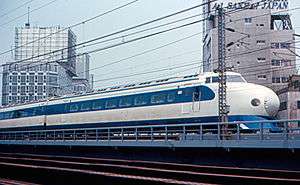
A 0 series Shinkansen high-speed rail set in Tokyo, May 1967
_-_53Fi1931_-_cropped.jpg)
Concorde 001 first flight in 1969

Space shuttle launch
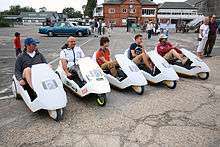
C5 enthusiasts gather at the Brooklands Museum
- 1950 - First Heritage railway.
- 1952 - Supramar launched the first commercial high-speed craft, a hydrofoil.
- 1952 - de Havilland Comet first commercial jet air liner.
- 1955 – First nuclear-powered vessel, USS Nautilus, a submarine, is launched.
- 1957
- Sputnik 1 – First artificial satellite to be launched into orbit.
- Gateway City – World's first purpose-built container ship, enters service.
- First flight of the Boeing 707 – First commercially successful jet airliner.
- 1959 - The first modern fuel cell vehicle was a modified Allis-Chalmers farm tractor, fitted with a 15 kilowatt fuel cell, around 1959.[31]
- 1961 – Vostok 1, first crewed space mission, designed by Sergey Korolyov and Kerim Kerimov, makes two orbits around the Earth with Yuri Gagarin.
- 1962 - The first ascending-gliding parachute was developed by Pierre-Marcel Lemoigne in 1962.[32][33][34]
- 1964 - Shinkansen first high-speed rail.
- 1966 - Caspian Sea Monster ground effect vehicle introduced.
- 1967 - Automatic train operation introduced on London Underground.
- 1968 - Space hopper invented.
- 1969
- First flight of the Boeing 747 – First commercial widebody airliner.
- NASA rocket technology, spurred on by the US/Russia Space Race – Makes the first crewed Moon landing a reality.
- Lolo ball invented.
- 1971 – Salyut 1, first space station, launched by Soviet Union.
- 1973 - Stadtbahnwagen B hybrid tram-train on heavy rail tracks developed. First modern premetro since interurbans.
- 1975 – Morgantown PRT, first Personal Rapid Transit system to be installed.
- 1976 – Concorde makes the world's first commercial passenger-carrying supersonic flight.
- 1977 - The first semi-automated car was developed in 1977, by Japan's Tsukuba Mechanical Engineering Laboratory, which required specially marked streets.
- 1981 – Maiden flight of the Space Shuttle.
- 1981 - The first fully Automated guideway transit driverless people mover train technology introduced on Port Island Line, Japan.
- 1983 - First Automated guideway transit driverless metro, and one of the first fully driverless train technologies, Véhicule Automatique Léger introduced in Lille Metro, France.
- 1984 - First commercial maglev, albeit low-speed opens in Birmingham.
- 1985 - Sinclair C5, the first mass-produced electric battery velomobile launched.
- 1989 - Snakeboard invented.
- 1990 - First transport simulation computer game Railroad Tycoon released.
- 1990 - ADtranz low floor tram world's first completely low-floor tram introduced.
- 1994 – Channel Tunnel opens.
- 1994 - Modern kickbike invented in Finland.
- 1997 – First Maglev train prototypes are tested in Japan.
- 1998 - Honda Raccoon Compo, first folding electric bicycle in Japan.[35]
- 1999 - Trikke (wiggle scooter) invented.
- 2000 - Honda Step Compo, first folding electric bicycle internationally available.
21st century

Concept modes of transport, AVENUE21 – Autonomer Verkehr, 2017
- 2001 - Germany trials capa vehicle hybrid buses in Nuremburg using an ultracapacitor to store electrical energy.
- 2002 – Segway PT self-balancing personal transport was launched by inventor Dean Kamen.
- 2003 - Concorde makes last passenger flight.
- 2003 - First modern Ground-level power supply technology, Bordeaux tramway.
- 2003 - Germany introduces capa vehicle trams in Mannheim.
- 2004 – First commercial high speed Maglev train starts operation between Shanghai and its airport.
- 2005 - Roller Buggy invented
- 2009 - Škoda 15 T world's first completely low-floor tram with articulated bogies introduced.
- 2010 – ULTra (rapid transit), the first modern commercial Personal Rapid Transit system to be installed. Started operations at Heathrow Airport.
- 2013 - Self-balancing scooter invented.
- 2015 - In March, China South Rail Corporation (CSR) demonstrated the world's first hydrogen fuel cell vehicle tramcar at an assembly facility in Qingdao.[36][37]
- 2017 - First 100% low-floor tram Ground-level power supply technology, TramWave, opening of Zhuhai tram China.[38]
- 2018 - Alstom Coradia Lint hydrogen-powered train entered service in Lower Saxony, Germany.
- 2018 - First driverless trams in Potsdam, Germany tested.[39]
- 2018 - First mass produced hydrogen fuel cell car, Toyota Mirai.
- 2019 - Autonomous Rail Rapid Transit opened in China.
gollark: Soooo what about items not in that set?
gollark: Yeees, kind of...
gollark: Also, that was even less helpful.
gollark: Unrelated factoid: the JSON file, pretty-printed, is 161271 lines and runs to nearly 5MB.
gollark: That would be hard.
See also
Notes
- A "tube" railway is an underground railway constructed in a cylindrical tunnel by the use of a tunnelling shield, usually deep below ground level.
References
- Casson (1971), pp. 68–69
- David W. Anthony, The Horse, the Wheel, and Language: How Bronze-Age Riders from the Eurasian Steppes Shaped the Modern World. Princeton University Press, 2010 ISBN 1400831105 p461
- King, David A. (1987). Islamic Astronomical Instruments. London: Variorum Reprints. ISBN 0860782018.
- "Der Reiszug – Part 1 – Presentation". Funimag. Retrieved 22 April 2009.
- Kriechbaum, Reinhard (15 May 2004). "Die große Reise auf den Berg". der Tagespost (in German). Archived from the original on 28 June 2012. Retrieved 22 April 2009.
- "1679–1681 – R P Verbiest's Steam Chariot". History of the Automobile: origin to 1900. Hergé. Retrieved 8 May 2009.
- Setright, L. J. K. (2004). Drive On!: A Social History of the Motor Car. Granta Books. ISBN 1-86207-698-7.
- "HOVERCRAFT BILL (Hansard, 16 May 1968)". Hansard.millbanksystems.com. Retrieved 3 May 2017.
- On foot: a history of walking - Google Book Search. books.google.co.uk. Retrieved 24 March 2009.
- C.D. Buchanan (1958). "1". Mixed Blessing: The Motor in Britain. Leonard Hill.
- Smiles, Samuel (1906). Lives of the engineers: Work of James Brindley; John Smeaton; John Rennie; Thomas Telford; George Stephenson; Robert Stephenson and others. UK: The Folio Society. p. 256. ISBN 0-7153-4279-7.
- Thomas, RHG (1980). The Liverpool and Manchester Railway. UK: BT Batsford Ltd. p. 15. ISBN 0713405376.
- Smiles, Samuel (2006). The Liverpool and Manchester Railway. The Folio Society. pp. 268–270. ISBN 0-7153-4279-7.
- Carlson, Robert (1969). The Liverpool and Manchester Railway Project. UK: David and Charles :Newton Abbot. p. 179. ISBN 0-7153-4646-6.
- Thomas, RHG (1980). The Liverpool and Manchester Railway. UK: BT Batsford Ltd. p. 95. ISBN 07134-05376.
- Thomas, RHG (1980). The Liverpool and Manchester Railway. UK: BT Batsford Ltd. p. 75. ISBN 07134-05376.
- Carlson, Robert (1969). The Liverpool and Manchester Railway Project 1821–1831. Newton Abbot: David and Charles. pp. 11–16. ISBN 0-7153-4646-6.
- Falco, Charles M.; Guggenheim Museum Staff (1998), "Issues in the Evolution of the Motorcycle", in Krens, Thomas; Drutt, Matthew (eds.), The Art of the Motorcycle, Harry N. Abrams, pp. 24–31, 98–101, ISBN 0-89207-207-5
- C. N. Pyrgidis. Railway Transportation Systems: Design, Construction and Operation. CRC Press, 2016. P. 156
- Ye. N. Petrova. St. Petersburg in Focus: Photographers of the Turn of the Century; in Celebration of the Tercentenary of St. Petersburg. Palace Ed., 2003. P. 12
- "Benz Patent Motor Car: The first automobile (1885–1886)". Daimler. Archived from the original on 21 October 2018.
- Wolmar 2005, p. 4.
- Eckermann, Erik (2001), World History of the Automobile, SAE, pp. 67–68, ISBN 9780768008005, retrieved 6 October 2013
- Electric Bicycle Guide
- "The First Zeppelins: LZ-1 through LZ-4". Airships.net. Retrieved 1 February 2014.
- MBTA (2010). "About the MBTA-The "El"". MBTA. Archived from the original on 26 November 2010. Retrieved 8 December 2010.
- "World War One: The tank's secret Lincoln origins". BBC News. Retrieved 1 April 2015.
- Glanfield, Appendix 2.
- Golfer Follows Ball In Car Run By Electricity", May 1932, Popular Mechanics article bottom of page 801
- The DC-3 Archived 5 December 2007 at the Wayback Machine
- Wand, George. “Fuel Cell History, Part 2” Archived 2015-04-02 at the Wayback Machine. “Fuel Cell Today”, April 2006, accessed August 2, 2011
- "Welcome to the Parasail Safety Council - Mark McCulloh".
- "Parasailing - Aloha Surf Guide".
- Al-Khatib, Talal (5 December 2011). "Parasailing: What You Need to Know Before You Go".
- Henshaw, David (1 June 2004). "Honda Step-Compo". A to B Magazine.
- "China Presents the World's First Hydrogen-Fueled Tram".
- "China Develops World's First Hydrogen-Powered Tram". IFLScience.
- 历经磨难 全球首个地面供电的100%低地板现代有轨电车项目终成正果
- https://www.theguardian.com/world/2018/sep/23/potsdam-inside-the-worlds-first-autonomous-tram. Missing or empty
|title=(help)
This article is issued from Wikipedia. The text is licensed under Creative Commons - Attribution - Sharealike. Additional terms may apply for the media files.

